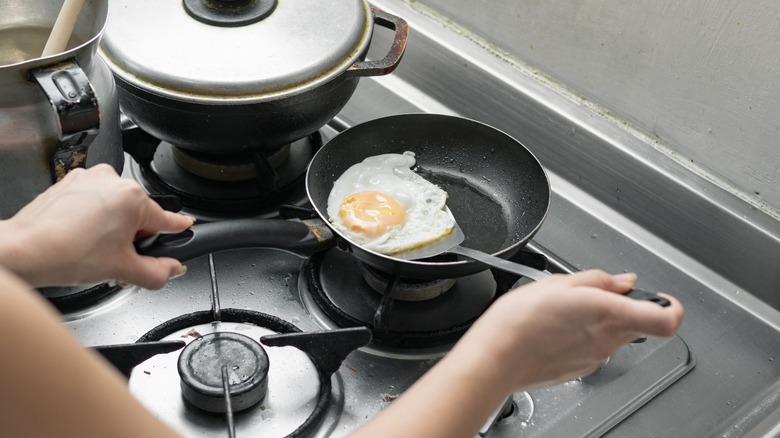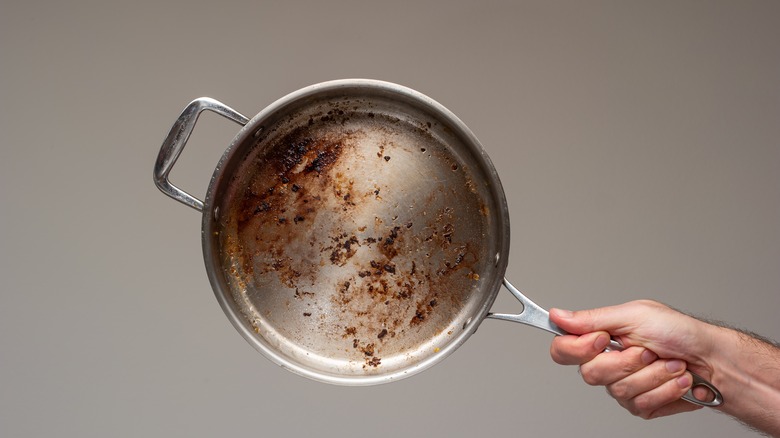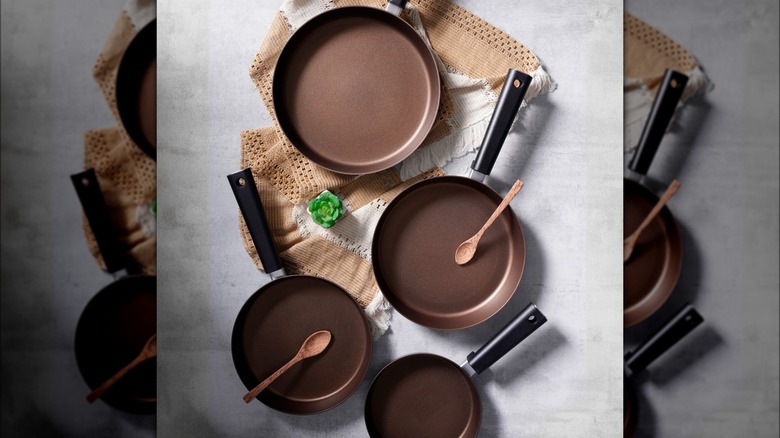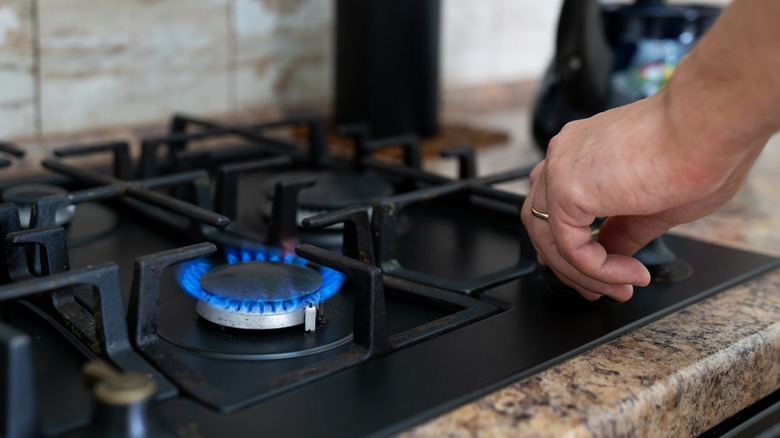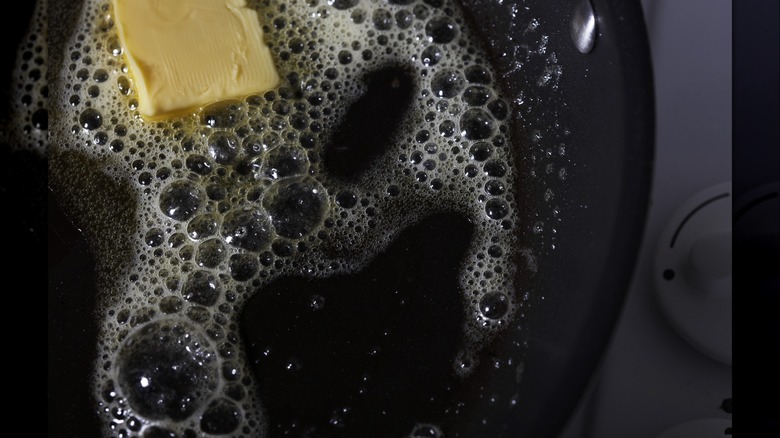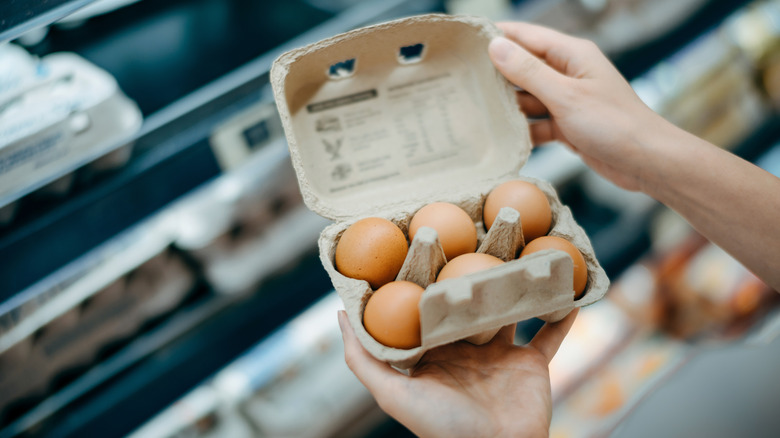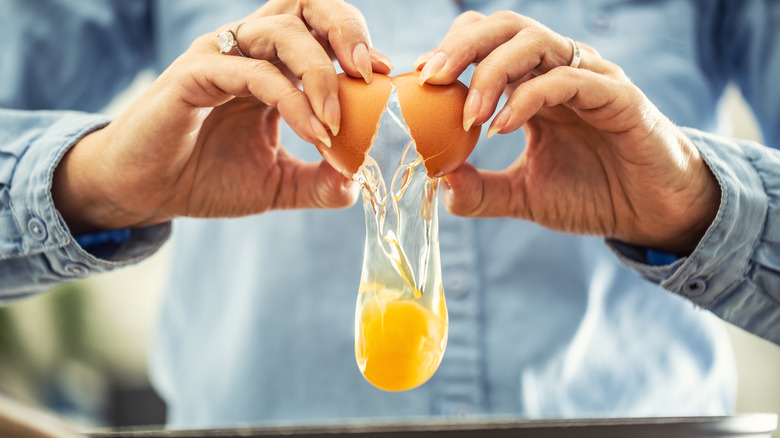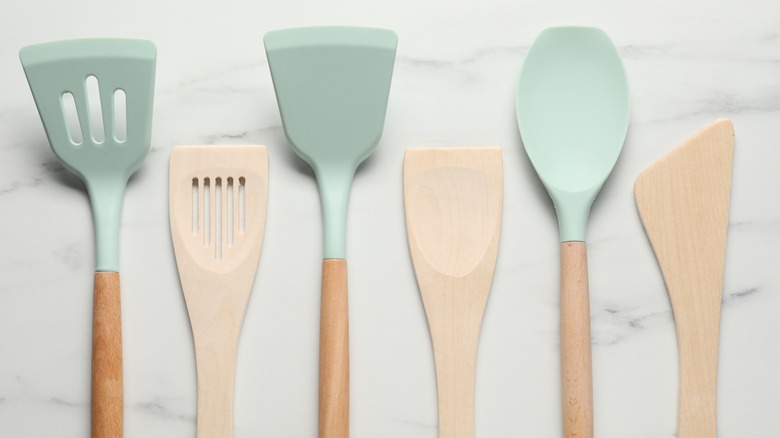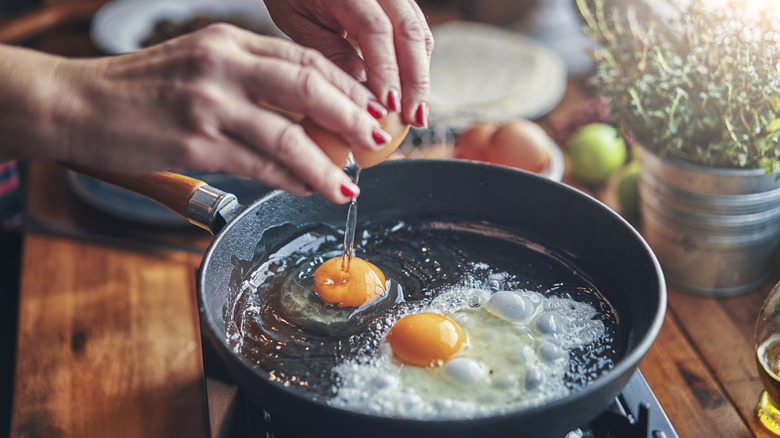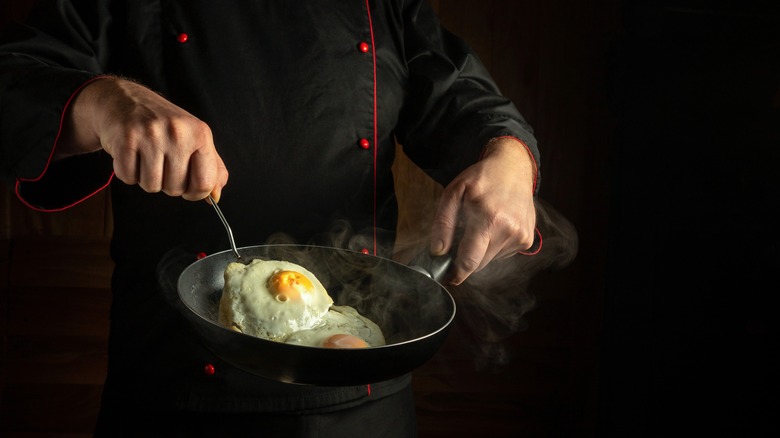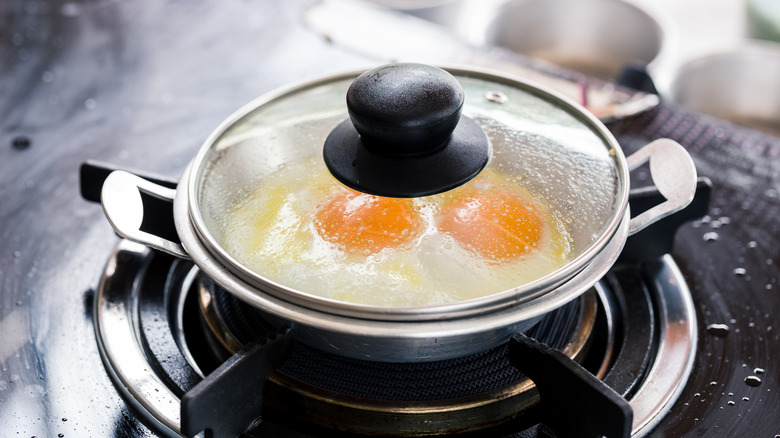Mistakes Everyone Makes When Flipping Eggs
Cooking eggs is one of the first things that people learn in the kitchen, and yet it is also something that budding chefs and home cooks commonly mess up. Specifically when it comes to flipping an egg — something that might seem straightforward, and equally where you really need to get the technique right. There are even over 15 million videos on Tiktok of people sharing their egg flipping fails. Although it's funny, messing up your egg flip can ruin your whole breakfast — and that, we cannot allow our readers to do.
There are many things to take into account when flipping an egg, and it all starts from the very beginning — right when you take your eggs out of the refrigerator. The eggs themselves, the pan type, the grease you're using, the spatula, the heat level, and more ... all can affect whether you nail your egg flip or flop it (literally).
We want you to have a delicious breakfast with stress free cooking and cleaning. To avoid your egg getting stuck to the pan, an accidentally broken yolk, or an unwanted kitchen mess — you'll want to check out our tips for how to flip your eggs perfectly every time.
Using a sticky pan
When getting ready to cook your eggs, you'll want to start off strong with the right equipment. People tend to have all different types of pans in their kitchen — from cast iron skillets, non-stick frying pans, stainless steel frying pans, and more.
The best option for flipping your eggs flawlessly, however, is a non-stick frying pan. This is the type of pan you'd find in the kitchen of any breakfast restaurant. Non-stick pans are made differently depending on the brand, but many have layers of a non-stick coating (usually made from various chemicals or ceramic). These types of pans make it incredibly easy to have the egg slide perfectly onto the spatula when it's time to turn, leaving little residue on the pan and a seamless flip.
Stainless steel pans are better reserved for cooking more heavy duty things like chicken and beef. If you were to cook an egg on a stainless steel pan, the chances of it sticking are quite high. This in itself makes the act of flipping incredibly difficult. You need a smooth, non-stick surface in order to have an easy egg flip.
Cast iron skillets can be used successfully to fry and flip an egg, but it's not the easiest choice. It takes a bit of finesse, including getting the right amount of oil and heat. Some people prefer to cook their fried eggs with the cast iron skillet because it creates crispy, fried edges, but for the perfect flip, non-stick wins out.
Using the wrong size pan
Now that you have your pan of choice, you need to make sure that you're using the correct pan size for the amount of eggs that you're cooking. If a pan is too small, it can cause eggs to cook unevenly. If the pan is too large, it can cause the eggs to spread out too thin and lose their shape.
If you are cooking one fried egg at a time, go for a smaller pan — approximately 6 inches should be perfect. You don't want the pan to be too small, because that can make flipping difficult. With the 6 inch pan, it'll prevent a single egg from running too much but leave you room to be able to get the spatula right under the egg.
For 2-3 eggs, you'll want to size up to about 8-10 inches. If you're really going for the gold and cooking 4-5 eggs, a 12 inch pan should be enough. Essentially, the more eggs you're cooking the bigger the pan required.
Not letting the pan preheat
Many people tend to rush when they cook eggs. This is probably because it's a common breakfast meal, and taking time to make breakfast in the morning usually means sacrificing some sleep. What you may not realize, however, is that not preheating your pan is only going to lead you to more cleaning time afterwards.
Preheating your pan is particularly important because if you put your eggs into the pan before it's hot enough, the egg white is likely to run. When that happens, the egg is more likely to stick to the pan, the shape is lost, and the ability to flip the egg seamlessly goes out the window.
If you set your pan up on a very low heat setting, and let it heat up for about 4-5 minutes (for a medium sized pan), you'll be good to go. If you're a bit impatient, make it a habit to get your pan straight on the stove before you start preparing for breakfast. Let the pan heat up while you gather all of your ingredients, get your coffee brewing, and then you can start cooking those eggs.
Not greasing the pan correctly
Even if you're using a non-stick pan, it's important to still grease it. You have two main options for types of grease: oil and butter. Both are valid options, but they bring slightly different results. As long as your grease is a fat source, it will work.
If you want to use oil, we recommend olive oil. It's one of the healthiest oils and works great with eggs. It specifically works well if you like your fried egg to be crispy on the edges. It also works great if you're going for an over-easy egg (where the yolk is still runny). You'll want to add your oil to the pan halfway through pre-heating it — that way you give the pan a chance to warm up, add the oil, let the oil get nice and warm, and then add your egg.
Using butter is a common choice, mainly because people enjoy the flavor that comes along with it. Butter is great if you like your egg white to be soft and creamy instead of crispy. Once you have about a minute left of your pre-heating time, you can place your butter in the pan. As soon as it's melted and slightly bubbling, it's time to add your egg.
Overall, you want to make sure you add your fat source to the pan after it's slightly warmed up. Leave just enough time for the oil or butter to slightly bubble, and then get your eggs cooking!
Not using fresh eggs
Now that you have the right pan, it's preheated, and greased correctly, you don't want to ruin your thoughtful preparation by using eggs that aren't fresh. We don't necessarily think you should only be using eggs straight from your neighbor's chicken coop, but it is wise to be more mindful when choosing your eggs at the grocery store.
When you're selecting your eggs, always check the date written on the carton. Most eggs list a "best-by" date, and consuming products after that date might mean they're not at their best. However, should you really be waiting to use your eggs right at the last minute? As time goes on, the eggs start to decline in quality. This can lead to the eggs being more runny than usual, which again can be harder to flip. This doesn't mean they're bad, but if you can eat your eggs closer to the time they were originally packaged, the better they'll be.
When picking up eggs at the store, try to get a carton that is all the way in the back. The freshest eggs will always be at the back of the refrigerator, because the store needs to sell the older eggs first. Another quick tip to make sure your eggs are at their best is to take them out of the refrigerator a few minutes before you start cooking them. If you place a very cold egg into a warmed up pan, it can cause the eggs to steam, and also take longer to cook.
Cracking your eggs straight into the pan
We've all been there — you're haphazardly cracking your eggs on the side of the pan, a little egg white runs down the side, and you plop the egg down into the pan only to see you let a few eggshells go with it. Sticking your fingers or a fork into a hot pan to get the shell out isn't really an option at that point, because the egg starts cooking immediately.
The best way to crack an egg is on a flat surface. This is because when you crack your egg on the corner of something (like a counter or the lip of the pan), it can actually push the eggshells into the egg — which causes them to get into the egg white. Cracking on a flat surface will help keep the shells out of your business.
Celebrity chef Bobby Flay never cracks his eggs directly into the pan. Instead, he cracks it into a small bowl or dish, and then carefully tips it into the pan. This way, if a shell does get in, he can easily get it out of the dish before putting it in the pan. This method also helps to control the placement of the egg in the pan, keeping it in its cooking spot without it spreading across the pan.
Using a poor spatula
There's a lot of prep work involved in getting the perfect eggs, but we are finally at the point where it's time to flip. You've started off strong with some fresh eggs that have been cooked properly on the correct pan. Now, you want to make sure you have the right spatula to do the job.
First make sure that the spatula is thin enough to slide perfectly under the egg. This will prevent you from accidentally pushing the egg onto itself, possibly cracking the yolk, or weakening the edges of the egg white. A thick spatula isn't going to be your friend when it comes to flipping.
If you went into the kitchen of your favorite breakfast restaurant, you would probably see the chef flipping eggs with a thin, metal spatula. They're the type with the little grates or holes on the surface — great for keeping the spatula lightweight, and making it easier to flip.
Silicone spatulas will do the job too, again as long as it is thin enough to fit under the egg. This flexible nylon spatula from Williams Sonoma is a great option, as it's manufactured specifically for cooking delicate foods like eggs. It's also a great option because it won't scratch your non-stick pan, which unfortunately, the thin metal spatulas can often do.
A good quality spatula will make or break your eggs, so make sure you invest in one that works.
Not cooking at the right temperature
The temperature that you cook your eggs at will directly affect your ability to flip the egg seamlessly. Now, this is completely dependent on what type of fried egg you are cooking — whether it's over-easy, over-medium, or an over-hard egg.
After you've preheated your pan on a low setting, you can change the temperature once the egg is on. If you're going for that ooey, gooey over-easy egg, you'll need to pay close attention to the heat levels. You can keep your heat level on low or slightly increase it to medium, and only let it sit for about 45 seconds to a minute before it's flip time.
For over-medium and over-hard eggs, you are safe in the medium heat range. Cook for a little longer before you flip, adding about 20 seconds for medium and an extra 20-30 seconds for over-hard. Keep monitoring your pan, however, because heat can build up, and if the pan gets too hot, your perfect egg flipping dreams will be out the window.
If the eggs are cracking and popping, turn that heat down. If smoke is sizzling up, you've gone too far. On the other hand, you could have the heat too low — if the egg whites aren't turning white and solidifying soon after you put the egg in the pan, you may need to increase the heat.
Attempting to flip at the wrong time
Many people make the mistake of trying to flip the egg at the wrong time. When this happens, you can accidentally break the yolk or cause the uncooked egg whites on top to slide off the cooked base. The good news is, if you've followed our tips up to this point, flipping the egg should go fairly seamlessly, as long as you do it at the right time.
The key to knowing it's time to flip is by keeping your eye on the egg whites. You want them to be fully white, with only clear parts left closest to the yolk. Another indicator is to check the edges of the egg white. If the edges have a clear shape (as in, they are solidified and not still malleable) you will be able to flip the egg fairly easily.
Start by testing the edge with the spatula to make sure that it will come up nicely and not still stick to the pan. It's always good to slightly loosen the egg with the edge of the spatula. Once you've done that, you can slide the spatula under the fried egg, lift it up, and flip!
Not trying the lid flipping method
Among other things, TikTok is a great place to find recipes and cooking hacks. One hack that took the app by storm is the method of flipping your eggs using the frying pan's lid. It's a great technique especially if you are making over-easy or over-medium eggs, because the chances of you breaking the yolk with this method are fairly slim.
For this method, take the pan and pick it up once the egg is ready to be flipped. Slightly shake the pan to loosen the egg (this is where using more grease can be helpful). Once the egg is seamlessly sliding around the pan, you can start the flip.
Take the lid and hold it upside down. Slowly slide the cooked egg into the lid (do not flip it in, making it go upside down). You want the yolk to remain facing up. Once it's slid into the lid, flip the pan to be placed on top of the lid, pressing firmly. Then, flip both hands 180 degrees and remove the lid. Your egg will be perfectly flipped and placed back into the pan ... as if by magic!
